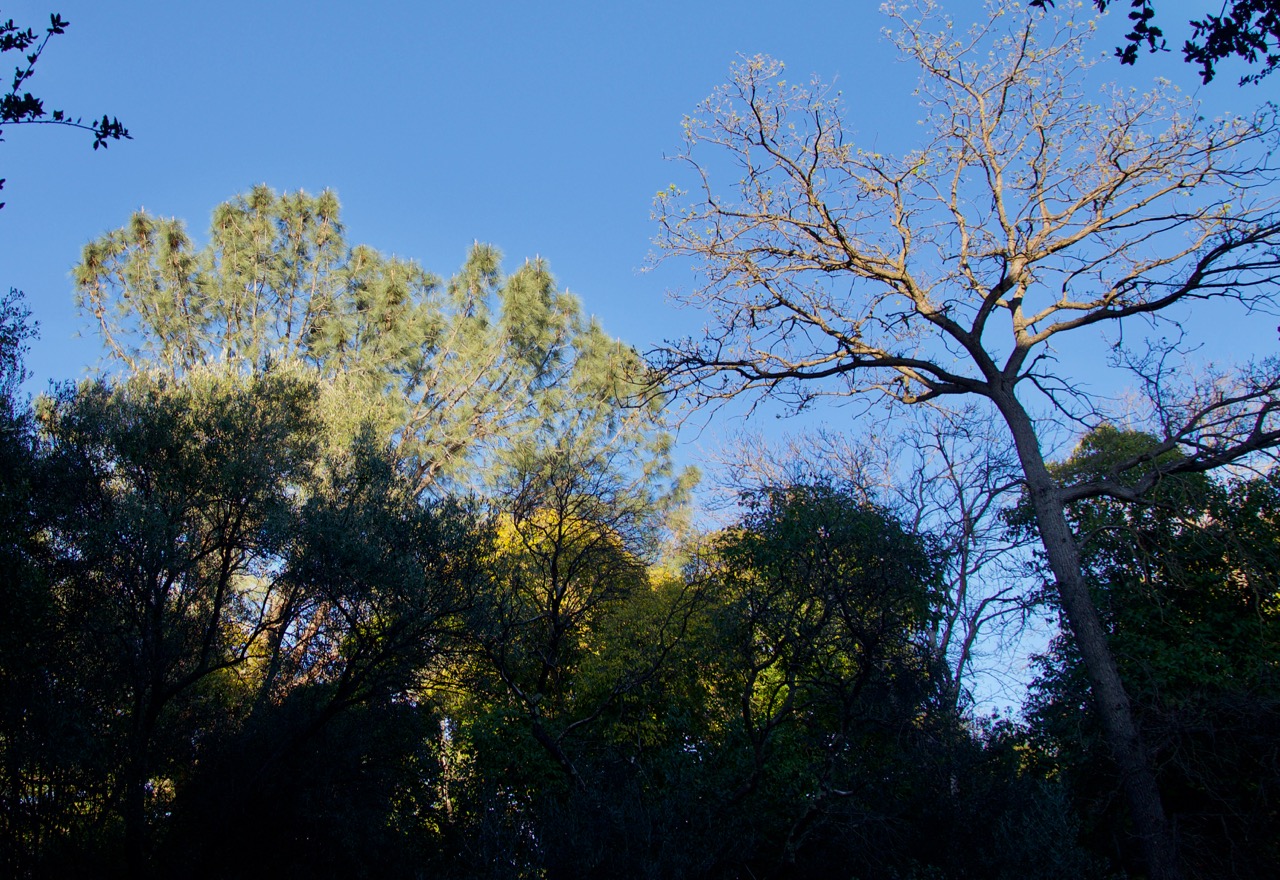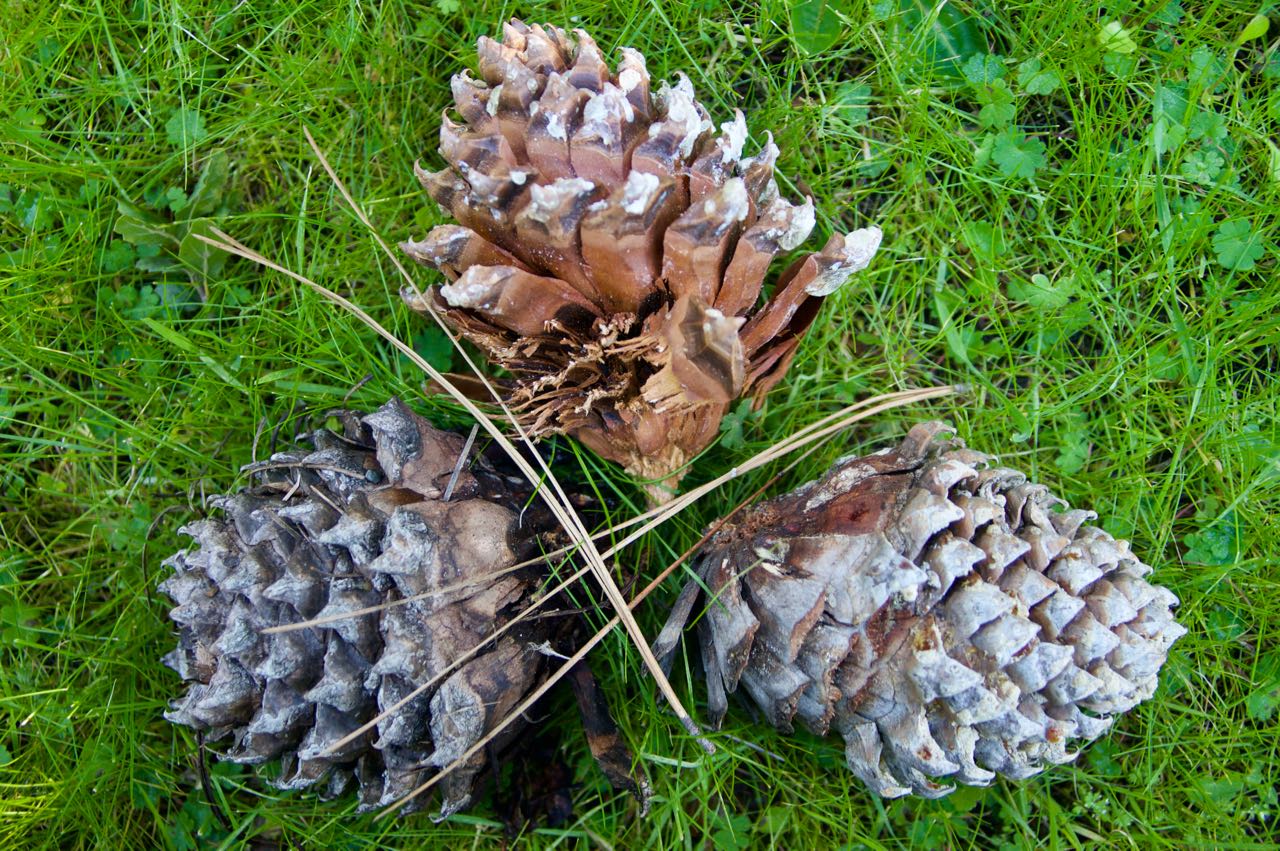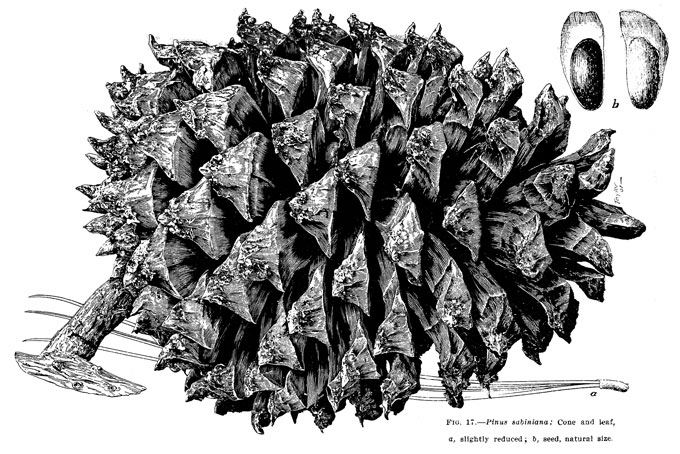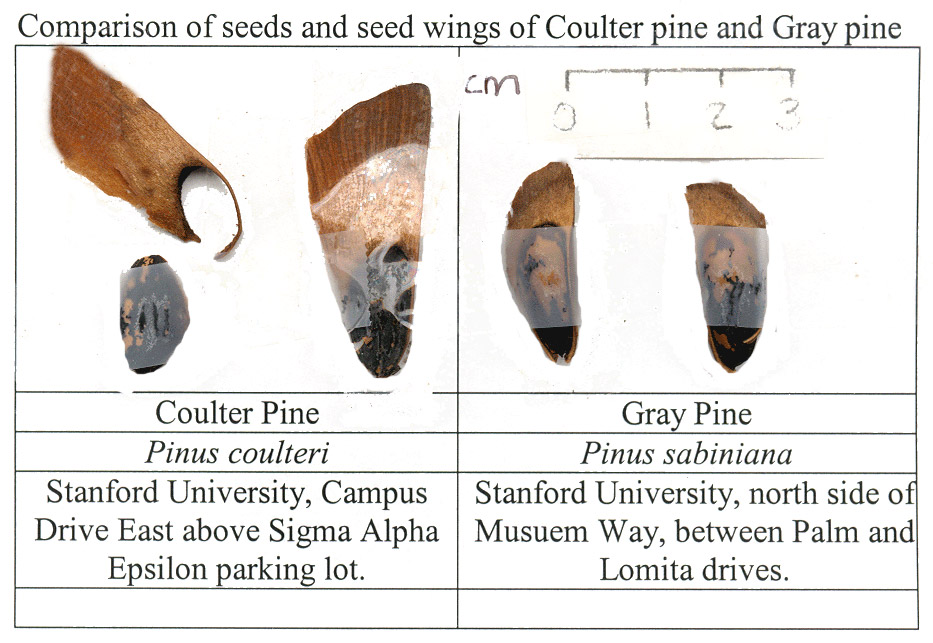Pinus sabiniana
 gray pine, foothill pine
gray pine, foothill pine


The three-needled gray pine, also known as foothill pine, digger pine*, bull pine, ghost pine, and grayleaf pine, is native to the slopes of the Santa Cruz Mountains in the area where they run down to the south end of San Francisco Bay, for example at Los Gatos and Loma Prieta. It also occurs elsewhere in the coast ranges and Sierra Nevada foothills.
The gray-green needles are around 10 inches long. The massive cones fall directly from the tree and can be found in nonweedy areas. An ingenious snap-fit design enables the seed to be removed from and then snapped back into its wing. As the wing is unsuitable for sailing on the wind, perhaps the seed counts on jettisoning the wing promptly to reduce hindrance to the means of dispersion it has in mind. Its plan may be to be washed downhill and buried by the rains. The cone design, with heavy recurved prickles and sticky pitch seems intended to foil animals from extracting the seeds by the natural route but the squirrels solve this problem by dismantling the cone scale by scale from the core out. On the other hand, perhaps as the cone armament evolved the cones became less palatable to beasts large enough to eat cones whole.
The seeds were a major source of food to the inhabitants of areas not far from campus but the acorn and buckeye were the source of flour at the various Native American sites actually on Stanford land.
Locations
Although gray pine is very attractive, it has received little attention in campus planting.
A handsome specimen towers over the coast live oaks at the southeast corner of Museum Way and Palm Drive, just south of the parking lot (location). A sizable specimen nearby, 70 yards east of the corner of Museum Way and Lomita Drive, was a survivor of several mentioned by George B. Culver in Stanford Illustrated Review, April 1927. It was removed summer of 2007; the sawn base was visible for a few years after that, and then disappeared.
See a vigorous specimen with strong ascending branches on top of the berm in the southeast part of Frost Amphitheater (location). Much of its crown is easily viewable from the path outside the amphitheater at that spot, to the east of the Littlefield Center.
One reported to be south of Crothers Memorial Hall was not seen as of February, 2018.
A significant group will be found by going to the end of Lathrop Place and taking the path alongside 950 into the greenbelt, where a trail runs along Junipero Serra Boulevard between Stanford Avenue and Frenchman’s Road. Three were found in March, 2018 upon taking a right onto the trail (location).
* On the term “digger pine”
Gudde, Erwin G. (Gustav). California place names: The origin and etymology of current geographical names. 4th ed. Rev. by William Bright. 1998:
Digger. “Root-Diggers… This name seems to embrace Indian tribes inhabiting a large extent of country west of the Rocky Mountains… With these tribes, roots are, for the great portion of the year, their main subsistence” (Schoolcraft, 1860, Archives of aboriginal knowledge, 6 vols. 4:221). The diggers also valued as food the green cones and the seeds of the Pinus sabiniana, whence the common designation Digger Pine. In California the name seems to have been used in a geographical sense mainly in Wintu territory. With the exception of a Digger Creek which empties into the ocean near Beaver Point [Mendocino], the existing Digger names are in Shasta, Tehama, and Trinity counties. The natives on Kings River were called Root Digger Indians in the Indian Report (pp. 236 f.).The term “Digger” as an ethnic label is now considered offensive. According to The Jepson Manual (TJM), p. 120, “gray or foothill pine… the common name digger pine is pejorative in origin, so best avoided.” This is also called ghostpine, bull pine, and grayleaf pine. For the controversy about the name “digger pine” see L. Hinton, 1992, News Native Calif. 6(1):14–15. Stephen W. Edwards, 1997, Four Seasons 10(3):49–51, prefers “ghost pine” because the species can be found up to about 2135 m (TJM gives only 1500 m el.), hence not “foothill,” and because in some places it is green, not “gray.”
· A simple key to campus pines
Name derivation: Pinus – Latin for pine; sabiniana – Joseph Sabine (1770–1837), English horticulturalist, founder of Transactions of the Royal Horticultural Society.
About this Entry: The main text of this entry is from the book Trees of Stanford and Environs, by Ronald Bracewell, published 2005. John Rawlings subsequently added the note on the removed tree at Museum and Lomita and the footnote on the term “digger.” Sairus Patel added the Frost location and noted the Crothers and Museum/Lomita trees was missing (Mar 2018); the Museum & Palm Drive location was added Dec 2018.





